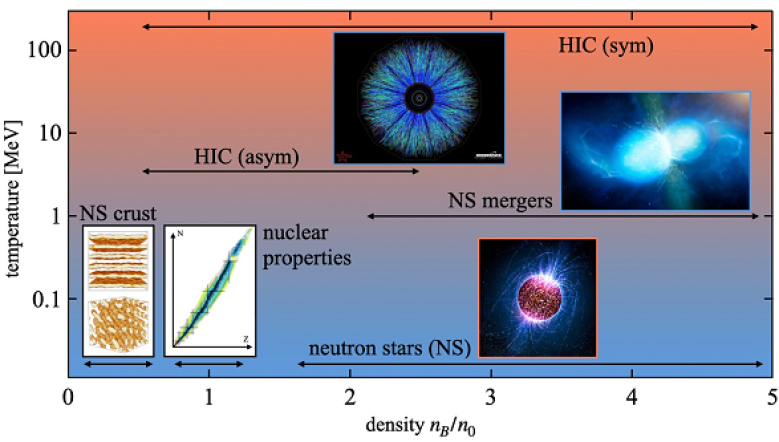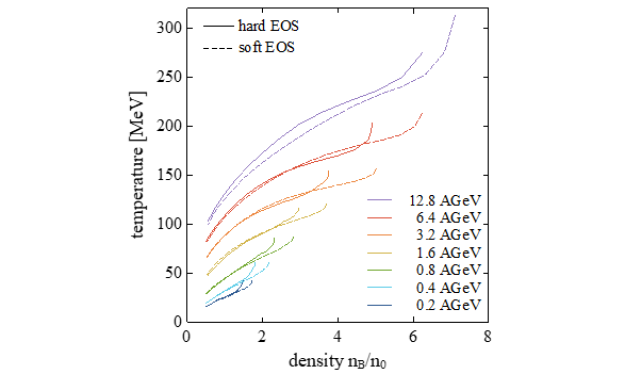INT 22-84W Highlights Report
Dense Nuclear Matter Equation of State
from Heavy-Ion Collisions
December 5 - 9, 2022
A. Sorensen, D. Oliinychenko, S. Pratt

FIG. 1: Schematic depiction of the ranges of density and temperature probed in experiments and astronomical observations sensitive to the EOS of nuclear matter. Figure from arXiv:2301.13253.
This workshop focused on constraining the density- and isospin-dependence of the dense nuclear matter equation of state (EOS), with a special emphasis on constraints obtained from experiments colliding heavy nuclei at high velocities, which probe nuclear matter within a wide range of densities (see Figs. 1 and 2). Despite active development in recent years, it is still a challenge for theoretical approaches to set constraints on the nuclear matter EOS at high baryon densities. Given the immense opportunity for uncovering the EOS using the upcoming high-quality and high-statistics experimental data, a large part of this workshop was devoted to evaluating the existing theoretical frameworks and identifying ways to improve them.

FIG. 2: Phase diagram trajectories of the central region in Au+Au collisions at zero impact parameter, obtained from hadronic transport simulations. The trajectories follow the evolution from the moment of the highest compression to densities around half the saturation density. Figure from arXiv:2301.13253.
Talks and discussions concentrated on using comparisons of state-of-the-art hadronic transport simulations with experimental data as a tool to extract the EOS. The workshop also highlighted the latest experimental measurements and future experimental programs as well as opportunities for combining constraints obtained from heavy-ion collisions with those obtained in other fields of nuclear physics, such as microscopic many-body theory calculations or astrophysical observations of neutron stars and neutron star mergers. Necessary improvements to hadronic transport codes were extensively discussed, with a particular focus on describing physics needed to fully understand experimental results from collisions at intermediate beam energies (from a few tens of MeV per nucleon to about 25 GeV per nucleon). The model advances discussed were directly relevant to the upcoming experimental results from the fixed-target campaign of the Beam Energy Scan program at RHIC, BNL, from the HADES and future CBM experiments at GSI and FAIR, Germany, and from collisions of neutron-rich isotopes at the newly commissioned Facility for Rare Isotopes Beams at Michigan State University.
The workshop has gathered together and strengthened ties between members of various subfields of the nuclear physics community sharing the goal of constraining the nuclear EOS. As a result of the workshop, a white paper has been written which highlights the role that heavy-ion collision experiments, and simulations used to describe them, can play, along microscopic calculations and astrophysical observations, in constraining the EOS (arXiv: 2301.13253).
